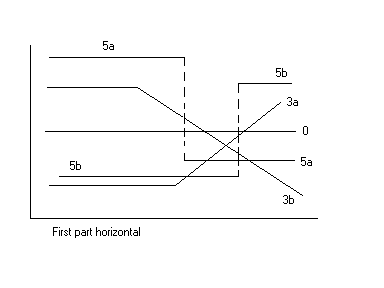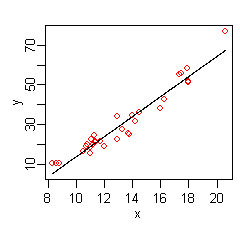|
Piecewise Regression
Segmented regression, also known as piecewise regression or broken-stick regression, is a method in regression analysis in which the independent variable is partitioned into intervals and a separate line segment is fit to each interval. Segmented regression analysis can also be performed on multivariate data by partitioning the various independent variables. Segmented regression is useful when the independent variables, clustered into different groups, exhibit different relationships between the variables in these regions. The boundaries between the segments are ''breakpoints''. Segmented linear regression is segmented regression whereby the relations in the intervals are obtained by linear regression. Segmented linear regression, two segments Segmented linear regression with two segments separated by a ''breakpoint'' can be useful to quantify an abrupt change of the response function (Yr) of a varying influential factor (x). The breakpoint can be interpreted as a ''critical' ... [...More Info...] [...Related Items...] OR: [Wikipedia] [Google] [Baidu] |
Regression Analysis
In statistical modeling, regression analysis is a set of statistical processes for estimating the relationships between a dependent variable (often called the 'outcome' or 'response' variable, or a 'label' in machine learning parlance) and one or more independent variables (often called 'predictors', 'covariates', 'explanatory variables' or 'features'). The most common form of regression analysis is linear regression, in which one finds the line (or a more complex linear combination) that most closely fits the data according to a specific mathematical criterion. For example, the method of ordinary least squares computes the unique line (or hyperplane) that minimizes the sum of squared differences between the true data and that line (or hyperplane). For specific mathematical reasons (see linear regression), this allows the researcher to estimate the conditional expectation (or population average value) of the dependent variable when the independent variables take on a given ... [...More Info...] [...Related Items...] OR: [Wikipedia] [Google] [Baidu] |
Student's T-test
A ''t''-test is any statistical hypothesis test in which the test statistic follows a Student's ''t''-distribution under the null hypothesis. It is most commonly applied when the test statistic would follow a normal distribution if the value of a scaling term in the test statistic were known (typically, the scaling term is unknown and therefore a nuisance parameter). When the scaling term is estimated based on the data, the test statistic—under certain conditions—follows a Student's ''t'' distribution. The ''t''-test's most common application is to test whether the means of two populations are different. History The term "''t''-statistic" is abbreviated from "hypothesis test statistic". In statistics, the t-distribution was first derived as a posterior distribution in 1876 by Helmert and Lüroth. The t-distribution also appeared in a more general form as Pearson Type IV distribution in Karl Pearson's 1895 paper. However, the T-Distribution, also known as Student's ... [...More Info...] [...Related Items...] OR: [Wikipedia] [Google] [Baidu] |
Regression Discontinuity Design
In statistics, econometrics, political science, epidemiology, and related disciplines, a regression discontinuity design (RDD) is a quasi-experimental pretest-posttest design that aims to determine the causal effects of interventions by assigning a cutoff or threshold above or below which an intervention is assigned. By comparing observations lying closely on either side of the threshold, it is possible to estimate the average treatment effect in environments in which randomisation is unfeasible. However, it remains impossible to make true causal inference with this method alone, as it does not automatically reject causal effects by any potential confounding variable. First applied by Donald Thistlethwaite and Donald Campbell (1960) to the evaluation of scholarship programs, the RDD has become increasingly popular in recent years. Recent study comparisons of randomised controlled trials (RCTs) and RDDs have empirically demonstrated the internal validity of the design. Example The ... [...More Info...] [...Related Items...] OR: [Wikipedia] [Google] [Baidu] |
Local Regression
Local regression or local polynomial regression, also known as moving regression, is a generalization of the moving average and polynomial regression. Its most common methods, initially developed for scatterplot smoothing, are LOESS (locally estimated scatterplot smoothing) and LOWESS (locally weighted scatterplot smoothing), both pronounced . They are two strongly related non-parametric regression methods that combine multiple regression models in a ''k''-nearest-neighbor-based meta-model. In some fields, LOESS is known and commonly referred to as Savitzky–Golay filter (proposed 15 years before LOESS). LOESS and LOWESS thus build on "classical" methods, such as linear and nonlinear least squares regression. They address situations in which the classical procedures do not perform well or cannot be effectively applied without undue labor. LOESS combines much of the simplicity of linear least squares regression with the flexibility of nonlinear regression. It does this by ... [...More Info...] [...Related Items...] OR: [Wikipedia] [Google] [Baidu] |
Multivariate Adaptive Regression Splines
In statistics, multivariate adaptive regression splines (MARS) is a form of regression analysis introduced by Jerome H. Friedman in 1991. It is a non-parametric regression technique and can be seen as an extension of linear models that automatically models nonlinearities and interactions between variables. The term "MARS" is trademarked and licensed to Salford Systems. In order to avoid trademark infringements, many open-source implementations of MARS are called "Earth". The basics This section introduces MARS using a few examples. We start with a set of data: a matrix of input variables ''x'', and a vector of the observed responses ''y'', with a response for each row in ''x''. For example, the data could be: Here there is only one independent variable, so the ''x'' matrix is just a single column. Given these measurements, we would like to build a model which predicts the expected ''y'' for a given ''x''. A linear model for the above data is : \widehat = -37 + 5.1 x ... [...More Info...] [...Related Items...] OR: [Wikipedia] [Google] [Baidu] |
Ordinary Least Squares
In statistics, ordinary least squares (OLS) is a type of linear least squares method for choosing the unknown parameters in a linear regression model (with fixed level-one effects of a linear function of a set of explanatory variables) by the principle of least squares: minimizing the sum of the squares of the differences between the observed dependent variable (values of the variable being observed) in the input dataset and the output of the (linear) function of the independent variable. Geometrically, this is seen as the sum of the squared distances, parallel to the axis of the dependent variable, between each data point in the set and the corresponding point on the regression surface—the smaller the differences, the better the model fits the data. The resulting estimator can be expressed by a simple formula, especially in the case of a simple linear regression, in which there is a single regressor on the right side of the regression equation. The OLS estimator is con ... [...More Info...] [...Related Items...] OR: [Wikipedia] [Google] [Baidu] |
Linear Regression
In statistics, linear regression is a linear approach for modelling the relationship between a scalar response and one or more explanatory variables (also known as dependent and independent variables). The case of one explanatory variable is called '' simple linear regression''; for more than one, the process is called multiple linear regression. This term is distinct from multivariate linear regression, where multiple correlated dependent variables are predicted, rather than a single scalar variable. In linear regression, the relationships are modeled using linear predictor functions whose unknown model parameters are estimated from the data. Such models are called linear models. Most commonly, the conditional mean of the response given the values of the explanatory variables (or predictors) is assumed to be an affine function of those values; less commonly, the conditional median or some other quantile is used. Like all forms of regression analysis, linear regressio ... [...More Info...] [...Related Items...] OR: [Wikipedia] [Google] [Baidu] |
Simple Regression
In statistics, simple linear regression is a linear regression model with a single explanatory variable. That is, it concerns two-dimensional sample points with one independent variable and one dependent variable (conventionally, the ''x'' and ''y'' coordinates in a Cartesian coordinate system) and finds a linear function (a non-vertical straight line) that, as accurately as possible, predicts the dependent variable values as a function of the independent variable. The adjective ''simple'' refers to the fact that the outcome variable is related to a single predictor. It is common to make the additional stipulation that the ordinary least squares (OLS) method should be used: the accuracy of each predicted value is measured by its squared '' residual'' (vertical distance between the point of the data set and the fitted line), and the goal is to make the sum of these squared deviations as small as possible. Other regression methods that can be used in place of ordinary least squa ... [...More Info...] [...Related Items...] OR: [Wikipedia] [Google] [Baidu] |
Chow Test
The Chow test (), proposed by econometrician Gregory Chow in 1960, is a test of whether the true coefficients in two linear regressions on different data sets are equal. In econometrics, it is most commonly used in time series analysis to test for the presence of a structural break at a period which can be assumed to be known ''a priori'' (for instance, a major historical event such as a war). In program evaluation, the Chow test is often used to determine whether the independent variables have different impacts on different subgroups of the population. Illustrations First Chow Test Suppose that we model our data as : y_t=a+bx_ + cx_ + \varepsilon.\, If we split our data into two groups, then we have : y_t=a_1+b_1x_ + c_1x_ + \varepsilon \, and : y_t=a_2+b_2x_ + c_2x_ + \varepsilon. \, The null hypothesis of the Chow test asserts that a_1=a_2, b_1=b_2, and c_1=c_2, and there is the assumption that the model errors \varepsilon are independent and identically distribut ... [...More Info...] [...Related Items...] OR: [Wikipedia] [Google] [Baidu] |
Mustard Segm Regr No Effect
Mustard may refer to: Food and plants * Mustard (condiment), a paste or sauce made from mustard seeds used as a condiment * Mustard plant, one of several plants, having seeds that are used for the condiment ** Mustard seed, seeds of the mustard plant used in cooking * Mustard greens (''Brassica juncea''), edible leaves from a variety of mustard plant * Mustard family, or Brassicaceae, a family of plants * Mustard Tree, or Salvadora Persica * Tomalley, sometimes called the "mustard" of a crab or lobster Science and technology * Mustard (color), a shade of yellow, similar to the color of the condiment * BAC Mustard (Multi-Unit Space Transport and Recovery Device), an experimental British spacecraft * Mustard gas or sulfur mustard, a chemical weapon * Nitrogen mustard, chemotherapy agents derived from mustard gas Other uses * Mustard (name), including a list of people with the name * ''Mustard'' (album), by Roy Wood * Colonel Mustard, a ''Cluedo'' character * Mustard (''My H ... [...More Info...] [...Related Items...] OR: [Wikipedia] [Google] [Baidu] |
Maxima And Minima
In mathematical analysis, the maxima and minima (the respective plurals of maximum and minimum) of a function, known collectively as extrema (the plural of extremum), are the largest and smallest value of the function, either within a given range (the ''local'' or ''relative'' extrema), or on the entire domain (the ''global'' or ''absolute'' extrema). Pierre de Fermat was one of the first mathematicians to propose a general technique, adequality, for finding the maxima and minima of functions. As defined in set theory, the maximum and minimum of a set are the greatest and least elements in the set, respectively. Unbounded infinite sets, such as the set of real numbers, have no minimum or maximum. Definition A real-valued function ''f'' defined on a domain ''X'' has a global (or absolute) maximum point at ''x''∗, if for all ''x'' in ''X''. Similarly, the function has a global (or absolute) minimum point at ''x''∗, if for all ''x'' in ''X''. The value of the function ... [...More Info...] [...Related Items...] OR: [Wikipedia] [Google] [Baidu] |
Optimization (mathematics)
Mathematical optimization (alternatively spelled ''optimisation'') or mathematical programming is the selection of a best element, with regard to some criterion, from some set of available alternatives. It is generally divided into two subfields: discrete optimization and continuous optimization. Optimization problems of sorts arise in all quantitative disciplines from computer science and engineering to operations research and economics, and the development of solution methods has been of interest in mathematics for centuries. In the more general approach, an optimization problem consists of maximizing or minimizing a real function by systematically choosing input values from within an allowed set and computing the value of the function. The generalization of optimization theory and techniques to other formulations constitutes a large area of applied mathematics. More generally, optimization includes finding "best available" values of some objective function given a ... [...More Info...] [...Related Items...] OR: [Wikipedia] [Google] [Baidu] |



_Density_Test_on_Data_from_Lee%2C_Moretti%2C_and_Butler_(2004).png)

